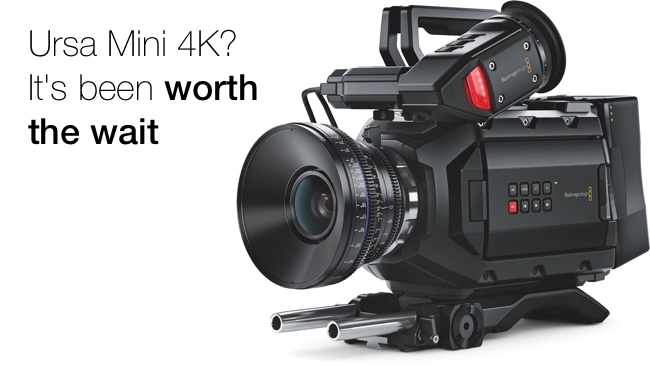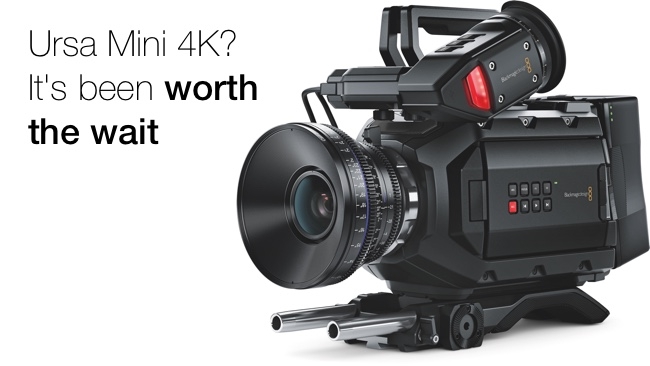
 Pushing the price/performance envelope
Pushing the price/performance envelope
RedShark 12 Days of Christmas Replays: Phil Rhodes takes a long, hard look at the Blackmagic Ursa Mini and concludes that this is a very important camera indeed.
Any analysis of a camera – or of anything, really – is always based on our requirements and expectations. Ten or fifteen years ago, cameras were clearly divisible into categories defined by their application: shoulder-mounted newsgathering, highly portable documentary on the better handycams, or high-grade cinema applications. The fact that these lines have become blurred indicates a growth in flexibility, though as a logical consequence it's very easy to slip into the trap of assuming that the most suitable design overall is the type with which one has the most experience.
All of this notwithstanding, I'm perfectly happy to report that the Blackmagic Ursa Mini is a pleasure to use principally because it can be set up very much like an ENG camera. This has been well-known since the camera's announcement at NAB, and it's nice to be able to confirm that it works very, very well.
On its own, the body is a straightforward square-sectioned shape with a battery mount on the back which ought to be applicable to a wide variety of circumstances. The joy of the thing, though, is in the optional shoulder kit; the top handle, and shoulder mount, along with the viewfinder, which together create the best implementation of a news-style camera that we've ever seen from something that wasn't just built as one from the ground up. The design direction is perhaps best expressed in the presence of a quick-release mount compatible with the ubiquitous VCT-14U plate bridging the shoulder pad. It is very lovely.
There have been complaints in the past that this layout can provoke long, unwieldy cameras. These concerns stem mainly from the days of the Sony F900 as a feature filmmaking device, where an initially longish setup could become practically prehensile given the addition of a video transmitter, radio mic receivers, downconversion and other modules between camera and battery. This is not a fate that the Ursa Mini suffers. Although it's really miniature only in comparison to the hulking Ursa, it certainly isn't long. In fact, like almost all modern cameras, the lack of a bulky tape deck means it isn't long enough to put the battery far enough back to balance anything other than the lightest lenses. Thankfully, many V-mount batteries will stack and I'm sure we would all rather carry more power than more electronics.
Picture this
The pictures from the 4K sensor, well-known from the company's previous efforts, are competent. Complaints of noise and limited sensitivity are unreasonable: the original Cinema Camera spoiled us in terms of sheer dynamic range. What everyone wants is those pictures at 4K resolution. The trick is in the degree of compromise and, crucially, how the new sensor stacks up against that in the competing Sony FS7. The 4.6K, if it's three quarters of what we hope it will be, might be a contender.
The Mini has four distinctly separated pages of menu options in the company's customary neatly-antialiased grey and yellow. These options have grown in complexity since the Cinema Camera to the point where scrolling is now necessary, which is fine. People have said that the menus on a Blackmagic camera seem childish, but – in all seriousness - compared to the competing million-option, multi-level monstrosities that pertain in cameras at this level, I'm with the Australian.
Touchscreens attract fingerprints, of course, but the control layout is fine. The assignable buttons are yet to be made active, but the the physical level controls for the audio (three cheers!) work fine. These are digital encoders which cause the sliders on the touchscreen to move, as opposed to potentiometers directly controlling an analogue amplification stage.
There is just one misstep in the layout, though it is significant – the power button is hidden under the flip-out TFT, which adds significant fumble factor to the cold-start time and promotes unnecessary wear on the wiring in the hinge. Putting the audio level controls here is one thing (they're sometimes under a cover on ENG cameras). Hiding the on switch is a questionable choice. Perhaps one of the external function buttons can become the power button - that, or have it start up when the power comes on, and hard switch it at the battery plate.
OLED viewfinder
The viewfinder is something we've talked about before. The ability to manufacture this device is largely dependent on access to a 1080p OLED panel of suitable size and Blackmagic has done well to be among the first to achieve it. It has good fill factor, avoiding the view-through-a-grid problem of many TFT viewfinders, and it's sufficiently bright where some early OLEDs weren't. Lag is impressively low, lower than some more expensive, lower-resolution third party options. The optical system doesn't create a particularly large apparent image size, but not to the point of inconvenience.
Because the viewfinder is widely being considered for non-Ursa applications we should address its functionality off the camera. The power and video inputs are standard, and thus, happily, so are the outputs on the camera, so it will as easily support a monitor or third-party EVF. There may be some additional considerations about supported signal formats. In general, though, the company confirms that the Ursa viewfinder can be considered general-purpose. By default, it's quite specifically engineered to be clamped in place under the top handle, which is good because it avoids the sloppiness of magic-armed viewfinders and rod arrangements like the FS7's. Having a viewfinder that's off level is disastrous. The adjustments for angle and horizontal extension are controlled from underneath and there's enough reach for left- or right-eye operating. The Ursa viewfinder is a highly noteworthy product all on its own.
The raw recording option, as well as all the relevant varieties of ProRes, all seem to be implemented in current 4K Minis. The choice of CFast is presumably provoked by the performance requirements for 4K raw, and draws comment because the format is stubbornly expensive. In fact, it's so expensive that anyone buying more than a couple of 256GB cards has spent more than the value of an Atomos Shogun, not that we'd really want to have to duct-tape an external unit to such an attractive little camera. Would SSD really have made for unacceptable bulk? Probably not. Anyway, CFast should start to drop in price at some point, and that'll only happen if people start using it more frequently. Recording formats are as expected, although it'd be nice to see interlaced modes in future updates, given the camera's apparent suitability for broadcast jobs.
So far, so good, but talk of broadcast work brings us back to one of the Ursa Mini's killer features: the combination of a B4 lens mount option, with optical correction for broadcast lenses, and windowing of the 4K sensor to suit the smaller image area of lenses intended for 2/3” cameras. Crucially, this lens mount is interchangeable, even in the field, with the PL option (a shim kit for maintenance of precision flange focal distance is available). This makes the Ursa Mini the only camera suitable, with the manufacturer's own options, for both big-chip cinematography on drama and music video, and small-chip news and documentary work.
It is not possible to fit the EF mount in place of the PL or B4, which is a pity because EF lenses, whatever their failings, are ubiquitous and PL lenses are expensive. The reason given for this limitation is that the EF mount is electronically active, to provide aperture control. Still, the ideal solution is a micro-four-thirds mount option to complement the B4 and PL. The company has done such things before, with an understanding of how they help generalise the camera, and this would facilitate various intermediate adaptors to other popular formats. Given this option, and interlaced video modes, the Ursa Mini would be close to being all things to everyone.
And the downside?
Articles like this traditionally end with a roundup of minor complaints. On the Ursa Mini this seems curmudgeonly; it is one of the most interesting cameras for years, demonstrating an understanding of ergonomics and flexible application that should draw raucous applause. Other than the minor concerns already mentioned, the biggest and most well-known single missing feature is an ND filter wheel. This really is a bit of an omission, presumably on the basis that it's a complex mechanical assembly of considerable manufacturing cost. Perhaps an in-mount variable ND accessory is possible.
Beyond that, concerns are few. The LUT options pale in comparison to those on the super-comprehensive FS7. The quality of the mic preamps is something we've yet to objectively test and there is no AES/EBU digital audio. The flip-out TFT is really a framing guide only – it indicates less highlight range than the OLED, prompting overcautious exposures. Whether the camera has sufficient electronic resources to tweak the TFT picture independently of the OLED is unknown, but it would be nice to see the clip point more accurately represented. The battery plate is mounted, for some reason, at an angle that looks rakish but means that any accessory stack will produce an XL1-style bent camera. Enterprising accessory manufacturers could offer a bolt-on wedge to make it vertical. There's no linear timecode output, although there is an input, and most productions could come up with a feasible workflow. There could be more function keys, based on an ENG camera's controls for white balance, gain and ND filtration.
But these are trivia. The camera competes, on the face of it, with the FS7. But Sony's effort, while more capable in terms of LUTs and frame rates, lacks in other areas. The Ursa Mini is capable of both big and small chip operation with a superb viewfinder and near-ideal ergonomics, and you're out of the door, with power and storage and maybe even some basic glass, for considerably under £10,000.
Yes. Yes please.
[List price - body only - is $2995. Availability is currently expected to be late October]
Tags: Production


Comments